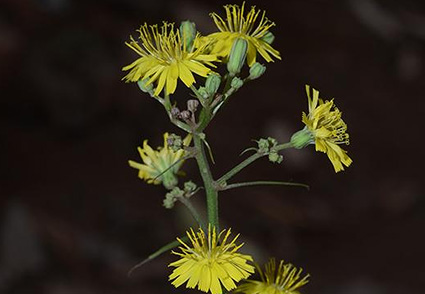Abstract
Youngia wulingensis, a new species of Asteraceae from Wuling Mountain, central China, is described and illustrated. This new species had been identified as Y. longipes for a long period of time. However, we rediscovered Y. longipes in its type locality, re-examined the type specimen of Y. longipes, and found out many differences between Y. longipes and Y. wulingensis, which can be easily distinguished by the shape of leaves and especially the cylindrical involucre with a keel-like central rib. The phylogenetic analyses based on the internal transcribed spacers (ITS) and one chloroplast marker (rps16) indicated that three accessions of Y. wulingensis were grouped together (BP = 1 and LP = 0.98) and appeared sister to Y. zhengyiana with strong support (PP = 1, LP = 0.98). Finally, we characterised the new species by morphological comparisons and molecular analyses.
References
- Babcock, E.B. & Stebbins, G.L. (1937) The genus Youngia. Carnegie Institution of Washington Publication 484: 1–106.
- Chen, Y.S. (2018) Youngia baoxingensis, a new species of Asteraceae (tribe Cichorieae) from Sichuan, China. Phytotaxa 382 (2): 239–242. https://doi.org/10.11646/phytotaxa.382.2.10
- Deng, T., Zhang, J.W., Zhu, X.X., Zhang, D.G., Nie, Z.L. & Sun, H. (2014) Youngia zhengyiana (Asteraceae, Crepidinae), a new species from south China, with notes on the systematics of Youngia inferred from morphology and nrITS phylogeny. Phytotaxa 170: 259–268. https://doi.org/10.11646/phytotaxa.170.4.3
- Gao, Z.L. (2007) Study on the subtribe Lactucinae of Compositae from Shandong. Master degree dissertation. Shandong Normal University. [in Chinese]
- Hall, T.A. (1999) BioEdit: A user-friendly biological sequence alignment program for Windows. Nuclc Acids Symposium Series 41: 95–98. https://doi.org/10.1021/bk-1999-0734.ch008
- Ke, R. & Chen, Y.S. (2016) A new species of Youngia (Asteraceae, tribe Cichorieae) from Yunnan, China. Phytotaxa 275: 140–148. https://doi.org/10.11646/phytotaxa.275.2.5
- Kilian, N., Gemeinholzer, B. & Lack, H.W. (2009) Tribe Cichorieae. In: Funk, V.A., Susanna, A., Stuessy, T. & Bayer, R. (Eds.) Systematics, evolution, and biogeography of the Compositae. IAPT, Vienna, pp. 343–383.
- Liu, Q., Huang, G.Y., Zhang, D.G., Zhang, J.W., Deng, T. & Li, Z.M. (2021) Youngia hangii (Asteraceae, Crepidinae), a new species from Hubei, China. PhytoKeys 182: 27–38. https://doi.org/10.11646/phytotaxa.275.2.5
- Nakamura, K., Chung, K.F., Huang, C.J., Kono, Y., Kokubugata, G. & Peng, C.I. (2012) Extreme habitats that emerged in the Pleistocene triggered divergence of weedy Youngia (Asteraceae) in Taiwan. Molecular Phylogenetics and Evolution 63: 486–499. https://doi.org/10.1016/j.ympev.2012.01.023
- Nakamura, K., Kono, Y., Huang, C.J., Chung, K.F. & Peng, C.I. (2013) Correction of confusions regarding the identity and synonymy of Youngia (Asteraceae: Tribe Cichorieae) in Taiwan. Systematic Botany 38: 507–516. https://doi.org/10.1600/036364413X666769
- Peng, Y.L., Gao, X.F. & Peng, L. (2013) Pollen morphology of Youngia and six related genera (Asteraceae: Cichorieae) and its systematic significance. Phytotaxa 139: 39–62. https://doi.org/10.11646/phytotaxa.139.1.2
- Peng, Y.L., Zhang, Y., Gao, X.F., Tong, L.J., Li, L., Li, R.Y., Zhu, Z.M. & Xian, J.R. (2014) A phylogenetic analysis and new delimitation of Crepidiastrum (Asteraceae, tribe Cichorieae). Phytotaxa 159: 241–255. https://doi.org/10.11646/phytotaxa.159.4.1
- Peng, Y.L., Ju, W.B., Gao, X.F. & Gao, Y.D. (2015) Youngia purpimea (Asteraceae), a new species from Sichuan, China. Phytotaxa 236: 191–195. https://doi.org/10.11646/phytotaxa.236.2.8
- Peng, Y.L., Gao, X.F. & Zhang, L.B. (2017) Youngia jiulongensis (Crepidinae, Cichorieae, Asteraceae), a new species from Sichuan, China. Phytotaxa 25 (3): 298–301. https://doi.org/10.3417/2015028
- Ronquist, F., Teslenko, M., van der Mark, P., Ayres, D.L., Darling, A., Hohna, S. & Huelsenbeck, J.P. (2012) MrBayes 3.2: Efficient Bayesian phylogenetic inference and model choice across a large model space. Systematic Biology 61: 539–542. https://doi.org/10.1093/sysbio/sys029
- Sennikov, A.N. & Illarionova, I.D. (2008) Generic delimitation of the subtribe Ixeridinae newly segregated from Crepidiinae (Asteraceae-Lactuceae). Komarovia 5: 57–115.
- Shih, C. (1993) On the classification of Ixeris group (Compositae) from China. Acta Phytotaxomica Sinica 31 (6): 533–548.
- Shih, C. (1997) Compositae (10). In: Ling, Y. & Shih, C. (Eds.) Flora Reipublicae Popularis Sinicae, vol. 80 (1). Science Press, Beijing, 106–266 pp. https://doi.org/10.2307/4111053
- Shih, C. & Kilian, N. (2011) Youngia. In: Wu, Z.Y., Raven, P.H. & Hong, D.Y. (Eds.) Flora of China, vols 20–21. Science Press, Beijing & Missouri Botanical Garden Press, St. Louis, pp. 252–263.
- Thompson, J.D., Higgins, D.G. & Gibson, T.J. (1994) CLUSTAL W: improving the sensitivity of progressive multiple sequence alignment through sequence weighting, position-specific gap penalties and weight matrix choice. Nucleic Acids Research 22 (22): 4673–4680. https://doi.org/10.1093/nar/22.22.4673
- Tremetsberger, K., Gemeinholzer, B., Zetzsche, H., Blackmore, S., Kilian, N. & Talavera, S. (2012) Divergence time estimation in Cichorieae (Asteraceae) using a fossil-calibrated relaxed molecular clock. Organisms Diversity & Evolution 13: 1–13. [http://www.springerlink.com/content/1439-6092]
- Urbatsch, L., Pruski, J.F. & Neubig, K.M. (2013) Youngia thunbergiana (Crepidinae, Cichorieae, Asteraceae), a species overlooked in the North American flora. Castanea 78: 330–337. https://doi.org/10.2179/13-018
- Wang, H., Wortley, A.H. & Blackmore, S. (2009) Pollen morphology of Crepidinae and Lactucinae (Asteraceae: Cichorieae) and its systematic significance. Grana 48: 160–178. https://doi.org/10.1080/00173130902931209
- Zhang, J.W., Nie, Z.L., Wen, J. & Sun, H. (2011) Molecular phylogeny and biogeography of three closely related genera, Soroseris, Stebbinsia and Syncalathium (Asteraceae, Cichorieae), endemic to the Tibetan Plateau, SW China. Taxon 60: 15–26. https://doi.org/10.1002/tax.601003
- Zhang, J.W., Boufford, D.E. & Sun, H. (2013) Systematic significance of achene morphology in Soroseris, Syncalathium and Parasyncalathium (Asteraceae: Cichorieae). Botanical Journal of the Linnean Society 173: 476–486. https://doi.org/10.1111/boj.12046
- Zhu, S.X., Qin, H.N. & Shih, C. (2006) Achene wall anatomy and surface sculpturing of Lactuca L. and related genera (Compositae: Lactuceae) with notes on their systematic significance. Journal of Integrative Plant Biology 48: 390–399. https://doi.org/10.1111/j.1744-7909.2006.00245.x


